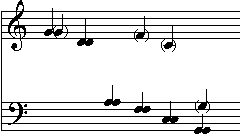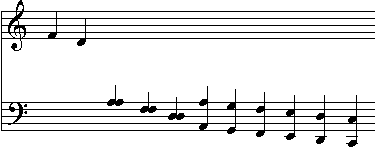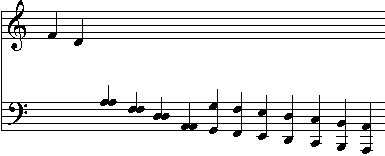|
|
 |
Theory and practice of play |
 |
|
|
 Renaissance lute. From the XVIth till the middle of the XVIIth
century. Renaissance lute. From the XVIth till the middle of the XVIIth
century.
During the XVI century existed seven dimensions of the lute, their mensure
fluctuated within 30-90 cm. Small octave lute, small discant lute, discant
lute, alto lute, tenor lute, bass lute, contrabass lute. The main lute
in the period of the XVIth century to the middle of the XVIIth century
was the tenor lute.

Bass strings were often doubled into the sonority.
 Baroque lute. XVIIth and XVIIIth centuries. Lutes pith in the
first years of the XVIIth century, a period when the lute receives ten-eleven
choirs and the pith in D-moll key. Baroque lute. XVIIth and XVIIIth centuries. Lutes pith in the
first years of the XVIIth century, a period when the lute receives ten-eleven
choirs and the pith in D-moll key.

Approximately in 1720 in Germany were added two new choirs and the total
number becomes thirteen.

 Theorbo, Chitarrone, Archilute... (there is a certain confusion
in designations) Theorbo, Chitarrone, Archilute... (there is a certain confusion
in designations)
Lute family differed by a constant evolution, this gave a ground for
the creation of different instrument kinds. Our ancestors of the XVIIth
- XVIIIth centuries were not unanimous by the determination of different
instruments and it is difficult now to give an exact description of
every type. For example, "Chitarrone" and "Theorbo"
are the italian designations where they were invented. Practically this
is one and the same instrument. Archilute differs from Theorbo only
by its dimension and its pith. Easier to say, all these instruments
can be named as "derivatives of the lute".
By origin of these instruments can be supposed: earlier the lute had
natural strings (sinews) which were good in the upper register and in
the low register they hadn't enough power. Musicians and makers who
was disturbed by this circumstance, added low strings to the lute, they
must be longer than high strings. The elongation of lute neck made inconvenience
in the playing. It was decided to give the expansion of the mensure
in the low register in form of the additional neck head. Now appeared
more distinct, clear and strong bass, and the instrument became more
even. This decision was satisfactory and it was accepted. Since that
time exist different lute dimensions provided by those heads. Low register
expansion gave positive moments in the ensemble playing too.
 Archilute. Archilute.
Very small size, pith of the first six strings is similar to the
lute.

 Theorbo. Theorbo.
Bigger and even very big with the special pitch, two first strings lowered
on octave.

 Lute strings. Lute strings.
At present time all lute performers use nylon strings (full nylon and
bass strings: nylon with copper thread). Obviously this is a recent
practice. All lute performers of the past used sinew strings (natural).
Sounding difference between nylon and sinews is very noticeable. Every
luteist, every lute amateur natural strings. He would feel differences
in lute sounding which we know today and how it differs from that which
heard our ancestors. |
|



